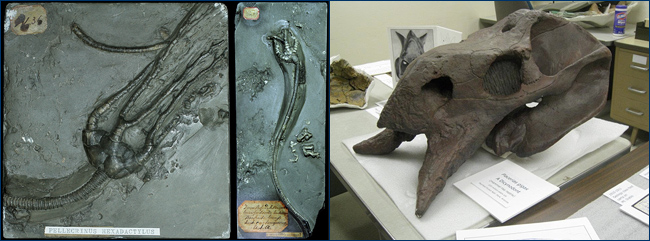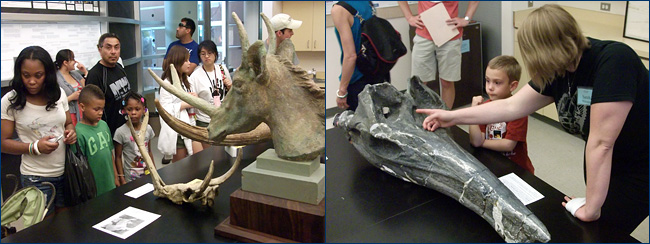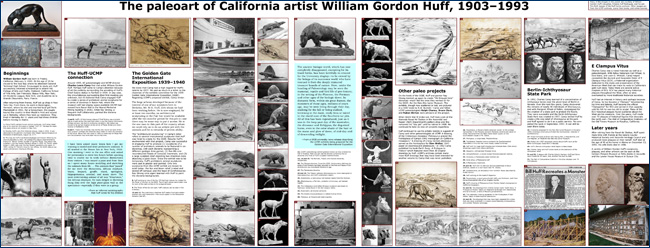
Left: Two crinoid fossils from the Crawfordsville crinoid collection purchased in 1887. Right: A cast of the skull of Placerias, a hippo-like dicynodont from the middle Triassic.
Cal Day 2012 highlights
Cal Day provided the perfect venue through which to share some of UCMP's hidden treasures, which have recently resurfaced thanks to a grant from the Mellon Foundation. This grant is allowing us to catalog our eclectic and extensive archives — including field notes, manuscripts, research notes, professional correspondence, locality information, maps, drawings, scientific illustrations, negatives, slides, and prints. A huge undertaking, but with the help of students, both graduate and undergraduate, plus some great volunteers (see volunteers story), progress is being made and the resulting "value added" to our specimen collections and to our understanding of the history of UCMP is extraordinary. Two of our Cal Day activities focused on these archival resources.
 Left: Two crinoid fossils from the Crawfordsville crinoid collection purchased in 1887. Right: A cast of the skull of Placerias, a hippo-like dicynodont from the middle Triassic. |
"Five fabulous fossil tales"
As part of the Berkeley Natural History Museums/Integrative Biology collaborative event in the VLSB courtyard, UCMP focused on how our archives add value to five fossils selected for display.
The most impressive fossil was a large cast of a Placerias skull. Placerias was a middle Triassic (220 million years old) dicynodont that looked somewhat hippo-like. The skull was collected by Charles Camp and Sam Welles in 1934 from near the Petrified Forest in Arizona. Adding value: pages from Camp's field notes, scientific illustrations, other drawings, and the monograph on Placerias.
Perhaps the prettiest fossils were beautifully prepared crinoids from Crawfordsville, Indiana. These stalked "sea lilies" (today, stalked crinoids are only found in the deep ocean) are from rocks of Mississippian age (359-318 million years old). This collection was purchased by the university in 1887, before UCMP existed. The fossils were prepared by and purchased from Professor D.A. Bassett of Wabash College in Indiana. Adding value: Bassett's correspondence with Cal's Joseph Le Conte in which Bassett describes the fossils and the two work out the details of the purchase.
 Some of the invertebrate fossils collected on the slopes of Mt. Diablo by Bruce Clarks' geology field class, 1910–1911. |
 [Click on the image to see an enlargement] Undergrad Alex Schwarz at the UCMP table in the courtyard. That's the skull of Placerias on her left and jaw of Triceratops on her right. |
Representing the paleobotany collections were middle Miocene (16 million years old) leaves from the Middlegate flora of Nevada collected by paleobotanist Daniel Axelrod. Adding value: A map from an Axelrod publication with reconstructions of Miocene climate in the western United States based on the Middlegate fossil leaf data.
Our fifth fossil was the jaw of Triceratops recovered from the Late Cretaceous (about 65 million years old) Hell Creek Formation of eastern Montana. Collected by Mark Goodwin in 1991, it is interesting to note that Mark was assisted by UCMP's graphic designer, Dave Smith, years before Dave became involved with the museum. Adding value: Goodwin's field notes and photos of the excavation.
Recreating prehistoric life: The specimens and the art
The Fishbowl, a meeting room just off UCMP's main office, was the location for another display highlighting our fossils, archives, and also the work of California artist, William Gordon Huff (see more of his paleoart). Thanks to documents in our archives, as well as additional artwork, memorabilia, and correspondence made available by two of Huff's children, Antonia Huff Rodrigues and Tim Huff, we are learning more about the UCMP-Huff connection.
 Left: Cal Day visitors are baffled by the horned, deer-like Synthetoceras. Right: Grad student Sarah Werning talks with a young visitor about Cymbospondylus, a Triassic ichthyosaur. |
Around 1935, UCMP director Charles Lewis Camp met Huff and engaged him to create a series of prehistoric animal sculptures for an exhibit in Bacon Hall, where the museum had display space. For the 1939-1940 Golden Gate International Exposition (GGIE) on Treasure Island, Camp looked to Huff again. Huff sculpted a number of prehistoric animals (one-sixth actual size) for six dioramas, as well as five life-size reconstructions of extinct mammal heads, and one very large relief depicting two American lions attacking a giant bison. Since the GGIE exhibit was to be temporary, Huff's prehistoric animal sculptures were cast in plaster and painted. Only two sculptures from that UCMP exhibit are known to exist today: the lions and bison relief, which is currently in storage, and one of the life-size heads: Synthetoceras, a deer-like artiodactyl from northern Texas and described by Ruben Stirton in 1932. This restored head, the skull on which it was based, and two other impressive fossils (which the public rarely gets to see because of their size and weight) were on view at Cal Day. The two others were (1) the skull of Cymbospondylus, a Triassic ichthyosaur from Nevada, and (2) the skull of a giant bison (Bison latifrons) — 6'8" from horn tip to horn tip — recovered by V.L. VanderHoof near Mt. Shasta. As with Synthetoceras, Huff had made a life-size head of the bison for the GGIE. Years later, Huff made a series of mini-murals for UCMP and two of these were also on display. One mural, depicting a number of beached ichthyosaurs, was based on Charles Camp's interpretation of the ichthyosaur "graveyard" found at what is now Berlin-Ichthyosaur State Park in Nevada, and it is very likely that Huff referred to the Cymbospondylus skull when drawing the ichthyosaurs. The second mural showed a Miocene landscape based on fossils found at the Black Hawk Ranch Quarry on the southwestern slopes of Mt. Diablo. A nine-foot, image-packed poster chronicled Huff's life and career, with a concentration on his paleoart and his relationship with UCMP.
 The nine-foot poster highlighting William Gordon Huff's paleoart that was prepared for Cal Day. |
 Other scenes from Cal Day. Top left: An animated Ashley Poust tells visitors about the huge skull of Bison latifrons. Top right: Grad student Maya deVries helps some young paleontologists identify microfossils at "Fun With Fossils." Bottom left: Anna Thanukos and Josh Frankel are kept busy at the tee shirt table. Bottom right: Museum Scientist Diane Erwin with a tour group in the collections. |
Crinoid photos by Dave Strauss; Placerias photo by Josh Frankel; Mt. Diablo invertebrate fossil photos by Susumu Tomiya; Alex Schwarz photo by Pat Holroyd; poster and photos of Sarah Werning, Ashley Poust, Maya deVries, and visitors with Synthetoceras by Dave Smith; photos of tee shirt table and Diane's tour by Jenny Hofmeister.